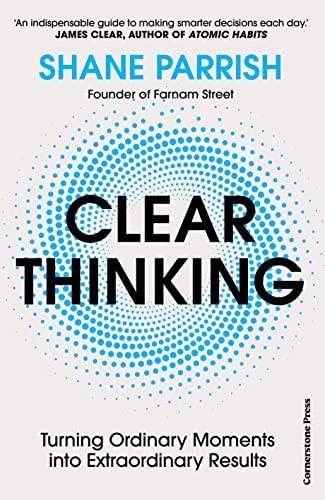Julian 's Key Ideas from Clear Thinking
by Shane Parrish
Ideas, facts & insights covering these topics:
18 ideas
·42.2K reads
110
2
Explore the World's Best Ideas
Join today and uncover 100+ curated journeys from 50+ topics. Unlock access to our mobile app with extensive features.
“In the space between stimulus and response, one of two things can happen. You can consciously pause and apply reason to the situation. Or you can cede control and execute a default behavior.”
SHANE PARRISH
467
4.73K reads
The Problem with Thinking
Our biggest problem with thinking is that we’re not really thinking in the situation where judgment is needed. We are reacting automatically based on our natural tendencies:
- Emotion default (responding to feeling rather than reason and fact)
- Ego default (protecting our self worth and position in hierarchy)
- Social default (conforming to social norms)
- Inertia default (seeking comfort and familiarity)
524
3.94K reads
“In order to be right, you must be willing to change your mind. If you’re not willing to change your mind, you’re going to be wrong a lot. The people who frequently find themselves on the wrong side of right are people who can’t zoom in and out and see the problem from multiple angles.”
SHANE PARRISH
481
3.21K reads
How To Build Strength
To overcome our defaults and improve our thinking, we must build strength to make a space for thinking between a situation and our response.
We need make it a habit and use inertia default for our benefit. Here are the source of strengths to be developed:
- Self-accountability (holding ourselves accountable for our actions)
- Self-knowledge (knowing our strengths and weaknesses)
- Self-control (mastering our emotions)
- Self-confidence (trusting our abilities)
498
3.08K reads
Decision Making Process
Once we’ve build the strength to create space for thinking, then we can apply clear thinking to make decision.
Decision is a judgment that certain option is the best one.
Decision making process is as follow:
- Define the problem
- Explore potential solutions
- Evaluate the options
- Make the judgment
- Execute the best option
498
2.74K reads
“There is a gap in our thinking that comes from believing that the way we see the world is the way the world really works. It’s only when we change our perspective—when we look at the situation through the eyes of other people—that we realize what we’re missing.”
SHANE PARRISH
439
2.27K reads
Criteria for Evaluating Options
When deciding between several options, you must have specific evaluation criteria with these features:
- Clarity: criteria must be clear, simple, and easily understood
- Goal Promotion: criteria must favor options that achieve desired goal
- Decisiveness: criteria must favor exactly one option.
For example, you want to live in suburb and look for new job. You can use the following criteria:
- Increased take home pay at least 30% (Clarity, Decisiveness)
- Allow work-from-home (Goal Promotion)
- You believe you can make impact in the first 90 days (Decisiveness)
483
2.79K reads
Most Important Thing
You must know what is the most important thing for you when using your selection criteria.
If you don’t know what it is, then you don’t fully understand the problem yet.
One way to find the most important thing is by listing down all the criteria, then compare in pairs (one-to-one) which criteria is more favorable when it’s true. Do it for all criteria until we find the ultimate winner.
470
2.33K reads
“There is only one most important thing in every project, goal, and company. If you have two or more most important things, you’re not thinking clearly. This is an important aspect of leadership and problem-solving in general: you have to pick one criterion above all the others and communicate it in a way that your people can understand so they can make decisions on their own.”
SHANE PARRISH
482
2.11K reads
Information You Need
Quality of your decision is determined by the quality of information you have. Most information is irrelevant. High quality information is both accurate and relevant.
Seek information from direct source. Run your own experiments. Learn from the real expert, not imitator or popularizer. Evaluate motivation and incentives of your source, because everyone has their own perspectives.
456
2.03K reads
The quality of your decisions is directly related to the quality of your thoughts. The quality of your thoughts is directly related to the quality of your information.
SHANE PARRISH
486
2.89K reads
How To Get Help From Experts
High quality information comes from experts. There are ways to approach them effectively:
- Show that you have skin in the game
- Be precise on what you’re asking
- Show respect for their time and energy
- Listen to their reasons
- Follow up and keep them updated
Experts love sharing what they know especially if it makes difference. Helping others make their life meaningful and they also enjoy doing what they’re good at.
467
1.79K reads
When To Take Action
At certain point, you must stop looking for more information and start taking action.
It depends on whether the decision is reversible or not and to what extent the outcome is consequential.
Take action based on the following rules:
- ASAP (as soon as possible): if the cost to undo the decision is low
- ALAP (as late as possible): if the cost to undo the decision is high
- FLOP (first lost opportunity): if we start losing options
For example, decide ASAP what to eat for breakfast, decide ALAP where to live, and be aware of FLOP when you choose where to have internship.
476
1.77K reads
Have Margin of Safety
Things don’t always go as planned. You need to have a buffer between what we expect to happen and what could happen. That’s margin of safety.
Engineers build a bridge to sustain more than double its maximum capacity. Investors only choose business they understand so that they can calculate the margin of safety. You need to save for rainy days.
423
1.47K reads
Learn from Your Decisions
Most people evaluate decision based on its outcomes, but they forget that there are outside factors, such as luck.
Quality of a decision is determined by the process and the reasoning used when the decision is made.
To evaluate your decision we need to make it visible by writing down your thoughts when you make the decision. Then you can evaluate whether the result is aligned with your expectation or not.
For example, a good trader usually keeps a trading journal to record each trade and reasoing behind it. This way allows them to learn what works and improve their trading skill over time.
429
1.32K reads
“Making a good decision is about the process, not the outcome. One bad outcome doesn’t make you a poor decision-maker any more than one good outcome makes you a genius. Unless you evaluate your reasoning at the time you made the decision, you’ll never know whether you were correct or just lucky.”
SHANE PARRISH
420
1.24K reads
Wanting The Right Thing
We’re making decision mostly to get what we want, but it’s equally important for us to know whether what we want is the right thing.
In the end, it’s about what matters in life. We all want a happy, fulfilling and enjoyable life. We need to think deeply on whether what we pursue align with our ultimate goal.
416
1.17K reads
“Good judgment is, above all else, about being effective at achieving what matters—not what matters in the moment, but what matters in life.”
SHANE PARRISH
420
1.29K reads
IDEAS CURATED BY
Lifelong learner and content creator. Helping you to find joy at work, get more things done, and be your best self.
CURATOR'S NOTE
This book is great because of its simplicity. For some readers, the ideas may not be new, but I think it’s because they’re true and proven to be effective. I am sharing here what’s most interesting to me plus additional examples to make it easier to understand.
“
Different Perspectives Curated by Others from Clear Thinking
Curious about different takes? Check out our book page to explore multiple unique summaries written by Deepstash curators:
20 ideas
Talha Mumtaz ✔️'s Key Ideas from Clear Thinking
Shane Parrish
13 ideas
Mr. Paredes's Key Ideas from Clear Thinking
Shane Parrish
1 idea
Kylen Lin's Key Ideas from Clear Thinking
Shane Parrish
Discover Key Ideas from Books on Similar Topics
17 ideas
Trump: The Art of the Deal
Donald J. Trump, Tony Schwartz
5 ideas
The House in the Cerulean Sea
TJ Klune
13 ideas
Smarter Faster Better
Charles Duhigg
Read & Learn
20x Faster
without
deepstash
with
deepstash
with
deepstash
Personalized microlearning
—
100+ Learning Journeys
—
Access to 200,000+ ideas
—
Access to the mobile app
—
Unlimited idea saving
—
—
Unlimited history
—
—
Unlimited listening to ideas
—
—
Downloading & offline access
—
—
Supercharge your mind with one idea per day
Enter your email and spend 1 minute every day to learn something new.
I agree to receive email updates








